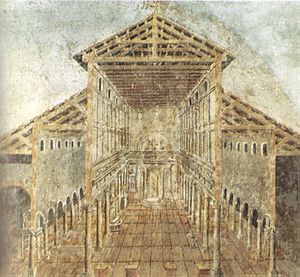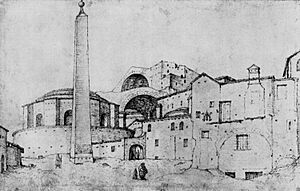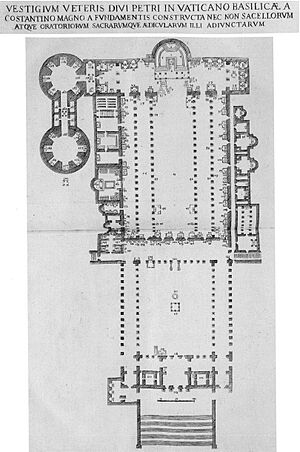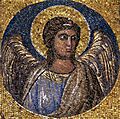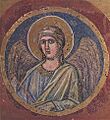Old St. Peter's Basilica facts for kids
Quick facts for kids St. Peter's Basilica |
|
|---|---|
|
Basilica Sancti Petri (Latin)
|
|
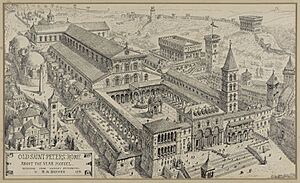
19th-century drawing of St. Peter's Basilica as it is thought to have looked around 1450. The Vatican obelisk is on the left, still standing on the spot where it was erected on the orders of the Emperor Caligula in 37 AD.
|
|
| 41°54′8″N 12°27′12″E / 41.90222°N 12.45333°E | |
| Location | Rome |
| Country | Papal States |
| Denomination | Catholic Church |
| History | |
| Status | Major basilica |
| Consecrated | c. 360 |
| Architecture | |
| Style | Early Christian |
| Groundbreaking | Between 326 and 333 |
| Completed | c. 360 |
| Demolished | c. 1505 |
| Administration | |
| Diocese | Diocese of Rome |
Old St. Peter's Basilica was a very old church. It stood in Vatican City for over 1,000 years. This was before the famous St. Peter's Basilica you see today was built.
The first church was built on the site of the Circus of Nero. Construction started when the Roman Emperor Constantine I was in charge. People started calling it "Old St. Peter's Basilica" after the new church was built. This helped everyone tell the two buildings apart.
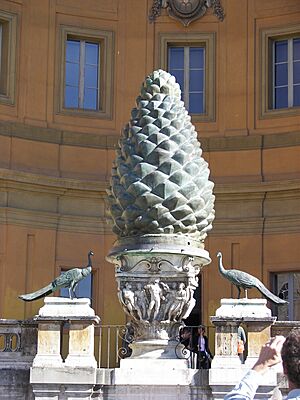
Contents
History of the Old Basilica
The building of Old St. Peter's Basilica began between 318 and 322 AD. Roman Emperor Constantine I ordered its construction after he became a Christian. It took about 40 years to finish.
Over the next 1,200 years, the church became very important. It grew into a major place for people to visit on pilgrimages in Rome.
Important Events and Challenges
Many important events happened at the basilica. Popes were crowned there. In 800 AD, Charlemagne was crowned emperor of the Carolingian Empire in the church.
In 846 AD, a group called the Saracens attacked and damaged the basilica. These raiders knew about Rome's amazing treasures. St. Peter's Basilica was outside the city walls, making it an easy target. It was full of valuable church items and holy relics. The raiders destroyed Saint Peter's tomb and stole from the holy shrine.
After this attack, Pope Leo IV built the Leonine wall to protect the Vatican. He also rebuilt the damaged parts of St. Peter's.
The Church Falls into Ruin
By the 1400s, the old church was starting to fall apart. Discussions began about how to fix it. This happened after the pope returned from Avignon.
Two people involved in the repairs were Leon Battista Alberti and Bernardo Rossellino. They improved parts of the church. However, Alberti thought the building was poorly built. He said it had very long, high walls with too many openings and no strong supports. He believed the wind had already pushed the wall quite a bit, and it might collapse.
Building the New St. Peter's
At first, Pope Julius II wanted to save the old building. But soon, he decided to tear it down and build a completely new church. Many people at the time were shocked by this idea. The old building showed a direct connection to Saint Peter and the popes who came after him.
The original altar was planned to be kept in the new church. The old church was torn down in 1505. Construction of the new church began the next year.
Design of the Old Basilica
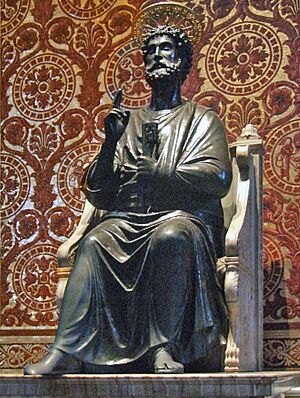
The design of Old St. Peter's was like a typical basilica. Its shape and height were similar to Roman public buildings. These included the Basilica Ulpia in Trajan's Forum and Constantine's own Aula Palatina in Trier. It was not designed like a Greek or Roman temple. Some think its design might have come from descriptions of Solomon's Temple.
Constantine worked hard to build the basilica on the spot he and Pope Sylvester I believed was Saint Peter's grave. This spot had been marked since at least the 2nd century. This choice affected the church's layout. It was built on the sloped Vatican Hill, on the west side of the Tiber River.
Since the site was outside the ancient city, the altar was placed in the west. This way, the church's front could be easily reached from Rome itself, which was to the east. Unlike older pagan temples, the outside of the church was not decorated in a fancy way.
Inside the Church
The church could hold between 3,000 and 4,000 people at one time. It had five aisles: a wide central nave and two smaller aisles on each side. These aisles were separated by 21 marble columns. These columns were taken from older pagan buildings.
The church was over 350 feet (107 meters) long. It was built in the shape of a Latin cross. It had a gabled roof made of timber on the inside. The roof stood over 100 feet (30 meters) high in the center. In the 6th century, a courtyard called the "Garden of Paradise" was added at the entrance. It had five doors leading into the church.
The altar of Old St. Peter's Basilica used several special twisted columns. People believed Constantine brought these columns from the Temple of Solomon. However, they probably came from a church in the East. When Gian Lorenzo Bernini built his famous canopy (called a baldacchino) over the new St. Peter's altar, he used the twisted design of these old columns. Eight of the original columns were moved to the new St. Peter's.
Beautiful Mosaics
The huge Navicella mosaic (1305–1313) in the courtyard is thought to be by Giotto di Bondone. This giant mosaic was ordered by Cardinal Giacomo Gaetani Stefaneschi. It covered the entire wall above the entrance facing the courtyard. It showed St. Peter walking on the water.
Most of this amazing mosaic was destroyed when the new St. Peter's was built in the 1500s. However, some pieces were saved. "Navicella" means "little ship." This refers to the large boat in the scene, with its sail full of storm winds. Showing a seascape so realistically was only known from very old artworks.
The nave ended with an arch. This arch had a mosaic of Constantine and Saint Peter. They were shown presenting a model of the church to Christ. On the walls, which had 11 windows each, were frescoes (wall paintings). These showed different people and scenes from both the Old Testament and New Testament.
According to old records, Giotto painted five frescoes about the life of Christ. He also painted other panels. Some of these were destroyed or moved when the new St. Peter's was built.
A small piece of an 8th-century mosaic, called the Epiphany, is one of the few remaining parts of the old church's medieval art. It is kept in the sacristy of Santa Maria in Cosmedin. It shows how high-quality the destroyed mosaics were. Another piece, a standing Madonna, is on an altar in the Basilica of San Marco in Florence.
Tombs and Burials
Since the crucifixion and burial of Saint Peter in 64 AD, people believed this spot was the location of Saint Peter's tomb. A small shrine stood there. As the church became more important, it was richly decorated. It had statues, furnishings, and fancy chandeliers. Side tombs and altars were added over time.
The church was filled with the tombs and bodies of saints and popes. Bones were still being found during construction as late as 1544.
Most of these tombs were destroyed when Old St. Peter's Basilica was torn down in the 1500s and 1600s. Only one was destroyed during the Saracen attack in 846. The remaining tombs, mostly just the stone coffins and their contents, were moved. They went to the modern St. Peter's Basilica, which stands on the same site. A few others went to different churches in Rome.
Only two papal tombs from the 1490s survived the demolition and were rebuilt in the present St. Peter's. These were by Antonio del Pollaiuolo for Pope Innocent VIII and Pope Sixtus IV. They were considered important and new artworks.
Many papal tombs were lost due to the rebuilding of St. Peter's. This is also true for tombs moved from the ancient Catacombs of Rome and those lost in two fires in the 1300s at the Archbasilica of Saint John Lateran. Because of this, Donato Bramante, the main architect of the modern St. Peter's Basilica, was sometimes called Maestro Ruinante (Master of Ruin).
The Stefaneschi Triptych
The Stefaneschi Altarpiece is a three-part painting called a triptych. It was created by the Italian painter Giotto. Cardinal Giacomo Gaetani Stefaneschi asked for it to be made. It was meant to be an altarpiece for one of the altars in Old St. Peter's Basilica in Rome.
This painting is a rare example of Giotto's work that has a clear record of who ordered it. It even has Giotto's signature. However, the exact date it was made is debated. Many experts think Giotto's workshop helped create it.
For a long time, people thought it was made for the main altar of the church. But newer research suggests it was placed on the "canon's altar." This altar was in the nave, just to the left of the large arch leading into the transept. Today, you can see it at the Pinacoteca Vaticana in Rome.
Images for kids
See also
- List of Greco-Roman roofs
- Index of Vatican City-related articles


